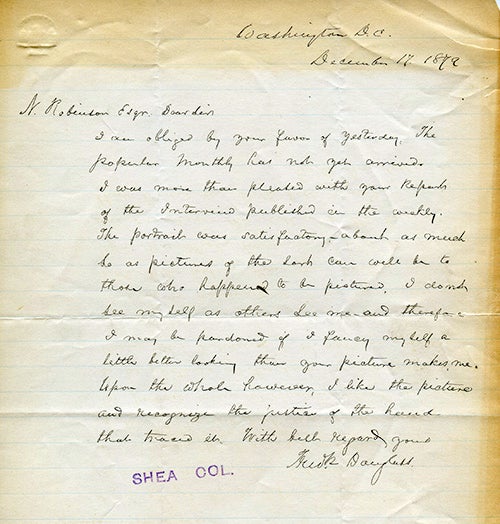The year 2018 marks the 200th anniversary of the birth of Frederick Douglass (circa February 1818 - February 20, 1895). Born into slavery in Tuckahoe, Maryland, Douglass boldly escaped from slavery to the North in 1838. For many years, he was active as a speaker and organizer in the abolitionist movement to end slavery in the United States. In 1845, he published his first autobiography, Narrative of the Life of Frederick Douglass, an American Slave. During the Civil War era, Douglass published his own abolitionist newspapers and spoke with President Abraham Lincoln on occasion. During Reconstruction, he continued to fight for civil rights for both African Americans and women.
From 1877 to 1881, Douglass served as the U.S. Marshal for the District of Columbia. On December 17, 1879, Douglass penned a letter to a Mr. Robinson about an image of himself that appeared in Frank Leslie’s Illustrated Newspaper, a notable newspaper of the time featuring images drawn from photographs and sketches.1 It seems that Mr. Robinson worked for Frank Leslie’s. That particular periodical published an interview with Douglass, accompanied by an etching, on December 13, 1879. In his letter, Douglass informed his correspondent that he “was more than pleased with your reports of the interview published in the weekly,” but then he weighed in on the accompanying image:
The portrait was satisfactory – about as much so as pictures of the sort can well be to those who happen to be pictured. I do not see myself as others see me and therefore I may be pardoned if I fancy myself a little better looking than your picture makes me. Upon the whole however, I like the picture and recognize the justice of the hand that traced it.

Douglass’s letter derives from the John Gilmary Shea papers (box 2, folder 52), a manuscript collection here at the Booth Family Center for Special Collections. Shea, the preeminent American Catholic historian of the nineteenth century, worked as an editor for Frank Leslie’s for a time. Shea was also an avid collector of documents and signatures of notable people, so it seems likely that he obtained this letter while working at the newspaper. The document bears the “Shea Col” stamp placed there by an archivist at Georgetown College (now University) after the Shea papers arrived at the Georgetown College archives in 1892.
In the interview in the December 13 edition of Frank Leslie’s Illustrated Newspaper, Douglass contends that although some African Americans may find opportunities in the North, others could find opportunities in the South. Douglass was aware of challenges in the South, however, as he said, “There is no doubt that in certain sections of the South, especially in Louisiana, Mississippi, and South Carolina, violence and intimidation have been resorted to.”
The image Douglass saw in Frank Leslie’s on December 13, reproduced below, depicts Douglass in his role as U.S. Marshal, seated at his desk in City Hall.

Douglass’s letter reflects his gentle sense of humor about his likeness. The etching it references, however, represents just one of the many images of Douglass made during his lifetime. Scholars John Stauffer, Zoe Trodd, and Celeste-Marie Bernier identified Frederick Douglass as “the most photographed American of the nineteenth century.”2 Through their research, the authors discovered 160 distinct photographs of Douglass. That figure does not include all of the engravings, lithographs, sketches, paintings, and other non-photographic images of Douglass over the years. The image from Frank Leslie’s seems to be an etching.
--Scott S. Taylor, Manuscripts Archivist
August 6, 2018
1Frank Leslie’s Illustrated Newspaper is available online from Accessible Archives. In the December 13, 1879 issue, the image of Douglass is on page 257 and the interview is on pages 258-259.
2John Stauffer, Zoe Trodd, and Celeste-Marie Bernier, Picturing Frederick Douglass: An Illustrated Biography of the Nineteenth Century’s Most Photographed American (New York: Norton, 2015), ix.
